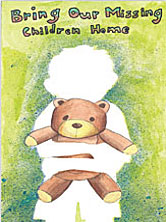AMBER Alert: 21 Years of Progress in Recovering Abducted Children
 The AMBER Alert system began in 1996, when Dallas-Fort Worth, TX, broadcasters teamed with local police to develop an early warning system to help find abducted children. Today, the system is being used in all 50 states, the District of Columbia, Indian country, Puerto Rico, the U.S. Virgin Islands, and 22 other countries. In addition to radio and TV, messages are delivered via Department of Transportation signs, cell phone notifications, digital billboards, Internet service providers, text alerts, and web and social media posts.
The AMBER Alert system began in 1996, when Dallas-Fort Worth, TX, broadcasters teamed with local police to develop an early warning system to help find abducted children. Today, the system is being used in all 50 states, the District of Columbia, Indian country, Puerto Rico, the U.S. Virgin Islands, and 22 other countries. In addition to radio and TV, messages are delivered via Department of Transportation signs, cell phone notifications, digital billboards, Internet service providers, text alerts, and web and social media posts.
OJJDP engages numerous partners across the nonprofit, corporate, and technology sectors to bolster the AMBER Alert program. Partners include the National Center for Missing & Exploited Children, federal law enforcement agencies, wireless carriers, Internet service providers, social media outlets, and the Outdoor Advertising Association of America. In addition, collaboration with apps, such as Waze and Uber, and other communications entities like Google and Bing are strengthening the AMBER Alert system and enhancing our nation’s capacity to locate and recover abducted children. As of December 2016, a total of 857 children had been successfully recovered through the AMBER Alert system.
January 13 is National AMBER Alert Awareness Day.
 2016 winning poster by Michael Wu from Walnut Elementary School in Walnut, CA.
2016 winning poster by Michael Wu from Walnut Elementary School in Walnut, CA.Deadline for Missing Children’s Day Poster Contest Is March 16
OJJDP invites fifth graders nationwide to participate in the 2017 National Missing Children's Day poster contest. The annual contest creates an opportunity for schools, law enforcement, and child advocates to discuss the issue of missing and/or exploited children with youth, parents, and guardians and to promote child safety. Submissions are due by March 16, 2017.
OJJDP will invite the national winner and his or her parents or guardians and teacher to Washington, DC, to participate in the National Missing Children's Day commemoration in May 2017. The ceremony honors the heroic and exemplary efforts of agencies, organizations, and individuals to protect children. National Missing Children’s Day has been commemorated in the United States since 1984, when it was first proclaimed by President Ronald Reagan.
OJJDP Funding Opportunities
Following are submission deadlines for fiscal year 2017 funding opportunities:
Mentoring Research Partners Program: February 22, 2017. The program will advance the independent evaluation of OJJDP-funded mentoring programs to improve the implementation and impact of the mentoring services that the Office supports.Smart on Juvenile Justice: Reducing Out-of-Home Placement Program: February 22, 2017. This program will strengthen and expand the use of community-based alternatives to out-of-home placement and minimize approaches based solely on control and deterrence in favor of individualized treatment and services.
Smart on Juvenile Justice: Technical Assistance To End Racial and Ethnic Disparities in the Juvenile Justice System: February 23, 2017. The program will provide resources and training and technical assistance on the most promising techniques to address disproportionate minority contact and eliminate racial and ethnic disparities within the juvenile justice system.
Coordinated Tribal Assistance Solicitation: February 28, 2017. This solicitation provides federally recognized tribes and tribal consortia an opportunity to develop a comprehensive and coordinated approach to public safety and victimization issues.
Smart on Juvenile Justice: Enhancing Youth Access to Justice Initiative: March 2, 2017. This initiative will provide funding to (1) develop and implement standards of policy and practice to manage well-resourced, statewide juvenile indigent defense systems; (2) develop state or regional resource centers to help juvenile defense systems enhance the quality of legal representation and collect and analyze data to measure the effectiveness of specific initiatives; and (3) support nonprofit organizations that provide direct civil legal services, mentoring, and reentry planning to youth.
Mentoring Opportunities for Youth Initiative: March 13, 2017. The program will support the implementation and delivery of one-on-one, group, peer, or a combination of these types of mentoring services to at-risk and high-risk youth populations.
Safe and Thriving Communities: Planning and Collaboration: April 3, 2017. Funding will support selected jurisdictions to undertake strategic planning and capacity-building work to address youth-related gun crime and gang violence.
Title II Formula Grants Program: April 17, 2017. The program will support efforts to plan, establish, operate, coordinate, and evaluate policies and projects for the development of more effective education, training, research, prevention, diversion, treatment, and rehabilitation programs and reform efforts in delinquency prevention and juvenile justice system improvement.
Department of Education Releases Resources Supporting System-Involved Youth
On December 2, 2016, the U.S. Department of Education announced the release of new guides and resources to help justice-involved youth successfully transition back to traditional school settings and avoid recidivism. The resources include a guide written for incarcerated youth, a newly updated transition toolkit and resource guide for practitioners in juvenile justice facilities, a document detailing education programs in juvenile justice facilities from the most recent Civil Rights Data Collection, and a website that provides t echnical assistance to support youth with disabilities transitioning out of juvenile justice facilities. The resources supplement the Department’s joint guidance with the U.S. Department of Justice to improve school climate and reduce the school-to-prison pipeline.
echnical assistance to support youth with disabilities transitioning out of juvenile justice facilities. The resources supplement the Department’s joint guidance with the U.S. Department of Justice to improve school climate and reduce the school-to-prison pipeline.
SAMHSA Issues Guidelines on Incorporating Youth Voices in Federal Events
The Substance Abuse and Mental Health Services Administration (SAMHSA) has published guidelines for effective youth engagement in federal government-sponsored meetings and events. The guidelines include tools and resources for government representatives to fully implement and model youth engagement. These tools were either developed or adapted by SAMHSA staff with the assistance of youth advocates from across the country and are tailored specifically for use by government representatives who are interested in engaging youth. The guidelines also include important tips for government representatives to use for successful engagement of youth before, during, and after government-sponsored events.
